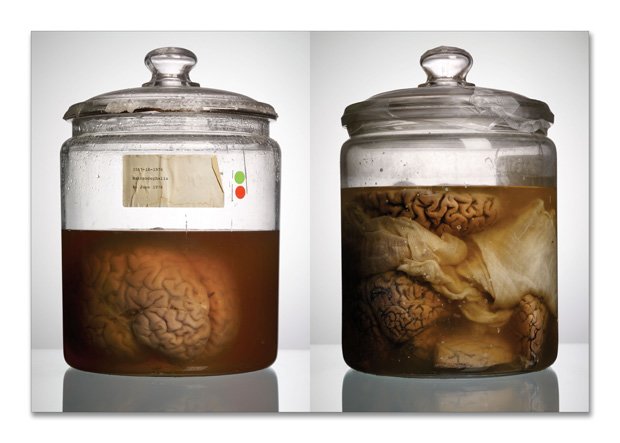MORE BRAINS! MALFORMED: FORGOTTEN BRAINS OF THE TEXAS STATE MENTAL HOSPITAL
MALFORMED: FORGOTTEN BRAINS OF THE TEXAS STATE MENTAL HOSPITAL
by Adam Vorhees and Alex Hannaford
Pros: Full of amazing photography and compelling supplemental material
Cons: Some will find this book to be grotesque and downright gross
Published in late 2014, Malformed: The Forgotten Brains of the Texas State Hospital combines eye-opening photographs with text to tell the story of a collection of around one hundred human brains taken from former patients at the Texas Lunatic Asylum (later known as the Texas State Hospital). Housed in large glass jars full of formalin (a mixture of formaldehyde and methyl alcohol) and assembled during a period from the early 1950s to mid ’70s, these brains exhibit a wide variety of abnormalities – presumably, they were preserved in order to hopefully shed new light on the various conditions suffered by the patients. In 1986, when it became apparent that Hospital could no longer care for the specimens, a “battle of the brains” ensued in which various institutions made a case for why they should acquire them. Eventually, the brains were transferred to the University of Texas at Austin’s Animal Resources Center where they’ve been used as teaching aids and research material.
One of the most astounding (and potentially disturbing) aspects of this book is the selection of crisp photographs included. Taken by Austin-based still-life photographer Adam Voorhees, these pictures are eerily beautiful, documenting many individual specimens of the collection, and the (sometimes, rather negligible) condition that they are in. Typically, the photos show an entire brain set against an almost disturbingly nondescript background, but various abstracts showing close-ups of either the brains themselves or the jars they are housed in are also included. A number of the collection’s specimens have been dissected in some manner and a handful of “teaching specimens” are also glimpsed in the pages of the book – these allow for more careful observation of the structure of the human brain, and many are dyed so that their different parts stand out. Among the more downright gross parts of the collection are jars in which various organs are included along with the brain, and a few in which portions of the scalp and cranial cavity have been preserved in their entirety.
Though indisputably macabre, the images here are also quite fascinating. It’s possible for a reader of this book to make note of how some brains are different from others: these subtle inconsistencies usually meant severe debilitation for the various patients from whom the specimens came. The majority of the brains in the collection are labeled with Latin descriptions of the afflictions suffered by the patients, and an observant reader will start to note certain characteristics relating to these conditions – for instance, dark coloration in the lobes reflects that the patient may have suffered a hemorrhage of some type. A few specimens are wildly asymmetrical, and one was almost smooth, suffering from a condition where the folds failed to develop. Perhaps one of the most interesting and somewhat tragic things about these specimens is that their descriptions sometimes reveal that the patients suffered from conditions that are much better understood and in some cases, actually treatable today. A remarkable number of these brains are identified as having come from persons with Down syndrome, and there’s no doubt this condition is handled much differently now than it was in the 1950s, ‘60s, and ‘70s.
Along with the photographs, Malformed includes several chapters of text by writer Alex Hannaford discussing the history of not only the collection, but also the Texas State Lunatic Asylum. This facility was constructed in the mid-1800s, accepting its first patient in 1864. Built on an idyllic stretch of land a few miles from (what was then) downtown Austin, the asylum was virtually self-sustaining, with crops, animals, and by the turn of the century, even its own power source on site. Hannaford relates various anecdotes about the hospital, drawing articles from the local newspaper to give credence to some of the stories, and I found this section of the text to be the most interesting since it inevitably chronicled the way in which societal views about mental illness and how it should be treated have changed over the decades. Later in the text, Hannaford examines the notion that nearly half of the collection – including the brain of UT sniper Charles Whitman – has disappeared. This is extremely unfortunate and largely mysterious, but even more troubling is the fact that the medical records of the patients whose brains are in the collection have also been lost. This makes in-depth study of the specimens difficult, but advancing technology would make up for this to some extent. The text concludes with a chapter that theorizes about how the brains will be used in the future, and the amount of knowledge that can be gained from them is virtually unlimited.
Roughly 180 pages in length, the book is very sharp-looking though the font size here is quite small. Regardless, I found Malformed to be easy to read since it never becomes overrun with scientific and medical jargon, and I think there’s a nice balance between the amount of text and number of images. One would think it would be easy to write an almost ghoulish, sensational text to go along with these photographs, but Hannaford’s writing is quite tasteful, emphasizing the more intriguing aspects of the collection and spurring the reader’s imagination. Clearly, the subject matter would limit this book’s appeal to mainstream readers, but there’s definitely a crowd out there who would find it fascinating – I was filled with a sense of wonder while reading and looking through it. In any case, Malformed: The Forgotten Brains of the Texas State Hospital has to be among the more unusual and esoteric coffee table books one would ever come across: it wouldn’t be to everyone’s liking, but I’d highly recommend it.














